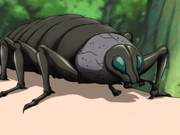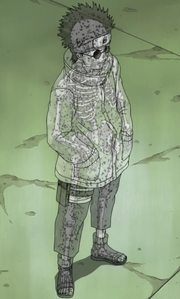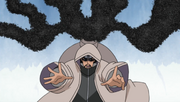Aged Goblin (talk | contribs) m (ref) |
No edit summary Tag: Visual edit |
||
| (42 intermediate revisions by 21 users not shown) | |||
| Line 1: | Line 1: | ||
| − | [[File:Kikaichū. |
+ | <section begin=summary />[[File:Kikaichū.png|thumb|A kikaichū.]] |
| − | + | {{translation|'''Kikaichū'''|寄壊蟲|engtv=Parasitic Insects|lit meaning=Parasitic Destruction Insects}} are one of several species of insect used by members of the [[Aburame clan]]. They resemble small, flight-capable [[Wikipedia:Beetle|beetle]]s.<section end=summary /> |
|
== Overview == |
== Overview == |
||
| − | [[File:Destruction Bug Host Technique.png|thumb|left|The kikaichū living inside |
+ | [[File:Destruction Bug Host Technique.png|thumb|left|The kikaichū living inside [[Shino Aburame]].]] |
| + | Shortly after an Aburame is born, kikaichū are allowed to colonise his or her body. In exchange for being allowed to feed off of their host's [[chakra]], the kikaichū follow the host's every command. The Aburame call this life-long symbiotic relationship the [[Parasitic Destruction Insect Technique|Kikaichū Technique]].<ref>''Naruto'' chapter 70, page 6</ref> If a colony becomes larger than what a single host's body can handle, the host may start carrying an {{translation|"insect jar"|虫袋|mushi bukuro}} for the excess kikaichū to live in.<ref>''Naruto'' chapter 517, page 10</ref> In the anime, kikaichū are shown abandoning the host's body if they deem it unpleasant, such as if the host takes a hot bath.<ref>''Naruto: Shippūden'' episode 236</ref> Alcohol consumption will also prevent the host from being able to control the kikaichū.<ref>''Boruto'' episode 50</ref> |
||
| − | Members of the Aburame clan actually live in symbiosis with the kikaichū through the [[Parasitic Destruction Insect Technique]]: the Aburame, shortly after birth, allows the kikaichū to nest and breed inside their bodies and feed off of their [[chakra]], and in return, the host ninja receives the life-long ability to control and command the bugs, using them as their primary fighting technique. |
||
| ⚫ | |||
| − | The most common use of the kikachū in combat is to silently ambush an opponent and [[Chakra Absorption Techniques|drain them]] of their chakra before they notice the bugs at work. This process can leave the victim with so little chakra that they are unable to move or fight back. In the anime, with proper control from the Aburame user, the kikachū are also shown able to [[Chakra Transfer Technique|transfer]] their accumulated chakra to others targets, replenishing them.<ref>''Naruto: Shippūden'' episode 304</ref> Other uses include simply tracking down a target, serving as a [[Insect Jar Technique|protective shield]] and as a [[Secret Technique: Insect Sphere|prison]] to hold and detain a target in place. |
||
| + | In combat, kikaichū are not deployed to make focused, precision strikes. Rather, they are spread across an area to cut off a target's escape and ultimately surround them. The kikaichū then descend upon the target and start consuming their chakra,<ref>''Naruto'' chapter 395, pages 2-7</ref> making them weaker until finally they can't move. While using a large swarm of kikaichū has the fastest results, smaller swarms have a better chance of going unnoticed by targets until it's too late for them to do anything.<ref>''Naruto'' chapter 126, pages 17-18</ref> If an opponent's [[jutsu]] are chakra-based, kikaichū can feed on the jutsu and thus neutralise them.<ref>''Naruto'' chapter 126, page 14</ref><ref>''Naruto'' chapter 427, page 13</ref> |
||
| + | Beyond offence, use of kikaichū grants several other options in battle. Aburame can use kikaichū to latch onto their surroundings, allowing them to perform manoeuvres they otherwise wouldn't be able to.<ref>''Naruto'' chapter 126, page 13</ref> In cases of [[poison]]ing, kikaichū can be used to remove the poison from the body.<ref>''Naruto'' chapter 137, page 11</ref> In the anime, kikaichū are shown distributing the chakra they've taken to allies, replenishing their reserves.<ref>''Naruto: Shippūden'' episode 304</ref> Defensively, kikaichū can surround their host as a [[Insect Jar Technique|protective shield]]<ref>''Naruto'' episode 150</ref> or [[Insect Clone Technique|impersonate their host]] to act as a decoy.<ref>''Naruto'' chapter 126, page 4</ref> If the host is trying to escape from combat or merely wants to obfuscate their actions, kikaichū can spread across the area and [[Insect Jamming Technique|emit their chakra]], making it difficult for [[sensor]]s to locate the host.<ref>''Naruto'' chapter 517, page 4</ref> |
||
| − | [[File:Shino preparing for battle.png|thumb|Shino with kikaichū surrounding him.]] |
||
| − | A female bug can be left on a target and then they can be tracked by smell, or scout bugs can be sent out and return to tell the host information about the area. Aburame members can also use their bugs to pull poison out of the body of other people; the bugs themselves are seemingly immune to poison.<ref>''Naruto'' chapter 137, page 11</ref> Thanks to the kikaichū, Aburame clan members are experts in espionage and search-and-seizure missions. They can also be used in great numbers to [[Insect Jamming Technique|jam chakra signals]], interfering with the abilities of [[sensor]] type shinobi. |
||
| + | Kikaichū are at their most useful when employed for tracking or other intelligence gathering. When an Aburame is looking for a target, they disperse their kikaichū across a large area to seek the target out. Once the target is found, the kikaichū reports their location back to the host. Because individual kikaichū appear no different than any other bug, they can be used to secretly observe a target and, upon returning to their host, communicate what they've learned.<ref>''Naruto'' chapter 41, page 14</ref> Once a kikaichū has locked onto a target's chakra signature, they will continue to follow it for as long as it's within their range.<ref>''Naruto'' chapter 395, page 9</ref> If an Aburame wants to be more discrete in their pursuit, a female kikaichū can be placed on a target; the female will give off a pheromone that males are able to home in on.<ref>''Naruto'' chapter 124, page 19</ref> |
||
| ⚫ | |||
| − | Since the kikaichū only have a lifespan of a few hours, they are expendable in combat. To maintain their numbers they are constantly reproducing within their host. If large numbers of the kikaichū should be wiped out, then [[Secret Technique: Insect Cocoon]] can be used to rapidly breed a whole new generation of the kikaichū, repopulating their numbers. |
||
| − | + | The anime has depicted kikaichū with several qualities that aren't seen elsewhere in the series, or at least aren't said outright. In one episode, kikaichū are shown to be effective counters against [[genjutsu]], because their [[Wikipedia:nervous system|nervous system]]s aren't complicated enough to be affected.<ref>''Naruto'' episode 207</ref> In another episode, kikaichū are noted to have short lifespans; if, in addition to this, much of the swarm is killed in battle, an Aburame can [[Secret Technique: Insect Cocoon|rapidly breed]] them to reestablish their population.<ref>''Naruto: Shippūden'' episode 95</ref> At times these short lifespans are advantageous to Aburame: if some of their kikaichū possess a mutation that makes them well-suited for a particular task, the mutation can be cultivated, spreading it to the rest of the colony within a few generations.<ref>''Naruto: Shippūden'' episode 104</ref> |
|
== Trivia == |
== Trivia == |
||
| − | * Kikai, when written as 奇怪, means "''strange''", or "''mysterious''" |
+ | * Kikai, when written as 奇怪, means "''strange''", or "''mysterious''". |
== See Also == |
== See Also == |
||
| − | * {{Drilldown|List of techniques that involve the kikaichū|Jutsu|q=Clan=Aburame Clan}} |
||
| − | * [[Nano-Sized, Venomous Insects]] |
||
* [[Bikōchū]] |
* [[Bikōchū]] |
||
| + | * [[Kidaichū]] |
||
| + | * [[Kochū]] |
||
| + | * [[Rinkaichū]] |
||
| + | * [[Shōkaichū]] |
||
== References == |
== References == |
||
<references/> |
<references/> |
||
| − | |||
| − | [[Contract::Shino Aburame| ]] [[Contract::Shibi Aburame| ]] [[Contract::Muta Aburame| ]] |
||
[[Category:Animals|Kikaichu]] |
[[Category:Animals|Kikaichu]] |
||
| + | [[Contract::Muta Aburame| ]] |
||
| + | [[Contract::Shibi Aburame| ]] |
||
| + | [[Contract::Shino Aburame| ]] |
||
| + | [[Contract::Torune Aburame| ]] |
||
| + | [[Contract::Harika Aburame| ]] |
||
| + | |||
| + | [[es:Kikaichū]] |
||
| + | [[id:Kikaichū]] |
||
| + | [[pt-br:Kikaichū]] |
||
| + | [[fr:Kikaichû]] |
||
| + | [[pl:Kikaichū]] |
||
Latest revision as of 15:46, 6 January 2023

A kikaichū.
Kikaichū (寄壊蟲, English TV: Parasitic Insects, literally meaning: Parasitic Destruction Insects) are one of several species of insect used by members of the Aburame clan. They resemble small, flight-capable beetles.
Overview

The kikaichū living inside Shino Aburame.
Shortly after an Aburame is born, kikaichū are allowed to colonise his or her body. In exchange for being allowed to feed off of their host's chakra, the kikaichū follow the host's every command. The Aburame call this life-long symbiotic relationship the Kikaichū Technique.[1] If a colony becomes larger than what a single host's body can handle, the host may start carrying an "insect jar" (虫袋, mushi bukuro) for the excess kikaichū to live in.[2] In the anime, kikaichū are shown abandoning the host's body if they deem it unpleasant, such as if the host takes a hot bath.[3] Alcohol consumption will also prevent the host from being able to control the kikaichū.[4]

Kikaichū deployed in battle.
In combat, kikaichū are not deployed to make focused, precision strikes. Rather, they are spread across an area to cut off a target's escape and ultimately surround them. The kikaichū then descend upon the target and start consuming their chakra,[5] making them weaker until finally they can't move. While using a large swarm of kikaichū has the fastest results, smaller swarms have a better chance of going unnoticed by targets until it's too late for them to do anything.[6] If an opponent's jutsu are chakra-based, kikaichū can feed on the jutsu and thus neutralise them.[7][8]
Beyond offence, use of kikaichū grants several other options in battle. Aburame can use kikaichū to latch onto their surroundings, allowing them to perform manoeuvres they otherwise wouldn't be able to.[9] In cases of poisoning, kikaichū can be used to remove the poison from the body.[10] In the anime, kikaichū are shown distributing the chakra they've taken to allies, replenishing their reserves.[11] Defensively, kikaichū can surround their host as a protective shield[12] or impersonate their host to act as a decoy.[13] If the host is trying to escape from combat or merely wants to obfuscate their actions, kikaichū can spread across the area and emit their chakra, making it difficult for sensors to locate the host.[14]
Kikaichū are at their most useful when employed for tracking or other intelligence gathering. When an Aburame is looking for a target, they disperse their kikaichū across a large area to seek the target out. Once the target is found, the kikaichū reports their location back to the host. Because individual kikaichū appear no different than any other bug, they can be used to secretly observe a target and, upon returning to their host, communicate what they've learned.[15] Once a kikaichū has locked onto a target's chakra signature, they will continue to follow it for as long as it's within their range.[16] If an Aburame wants to be more discrete in their pursuit, a female kikaichū can be placed on a target; the female will give off a pheromone that males are able to home in on.[17]
The anime has depicted kikaichū with several qualities that aren't seen elsewhere in the series, or at least aren't said outright. In one episode, kikaichū are shown to be effective counters against genjutsu, because their nervous systems aren't complicated enough to be affected.[18] In another episode, kikaichū are noted to have short lifespans; if, in addition to this, much of the swarm is killed in battle, an Aburame can rapidly breed them to reestablish their population.[19] At times these short lifespans are advantageous to Aburame: if some of their kikaichū possess a mutation that makes them well-suited for a particular task, the mutation can be cultivated, spreading it to the rest of the colony within a few generations.[20]
Trivia
- Kikai, when written as 奇怪, means "strange", or "mysterious".
See Also
References
- ↑ Naruto chapter 70, page 6
- ↑ Naruto chapter 517, page 10
- ↑ Naruto: Shippūden episode 236
- ↑ Boruto episode 50
- ↑ Naruto chapter 395, pages 2-7
- ↑ Naruto chapter 126, pages 17-18
- ↑ Naruto chapter 126, page 14
- ↑ Naruto chapter 427, page 13
- ↑ Naruto chapter 126, page 13
- ↑ Naruto chapter 137, page 11
- ↑ Naruto: Shippūden episode 304
- ↑ Naruto episode 150
- ↑ Naruto chapter 126, page 4
- ↑ Naruto chapter 517, page 4
- ↑ Naruto chapter 41, page 14
- ↑ Naruto chapter 395, page 9
- ↑ Naruto chapter 124, page 19
- ↑ Naruto episode 207
- ↑ Naruto: Shippūden episode 95
- ↑ Naruto: Shippūden episode 104
